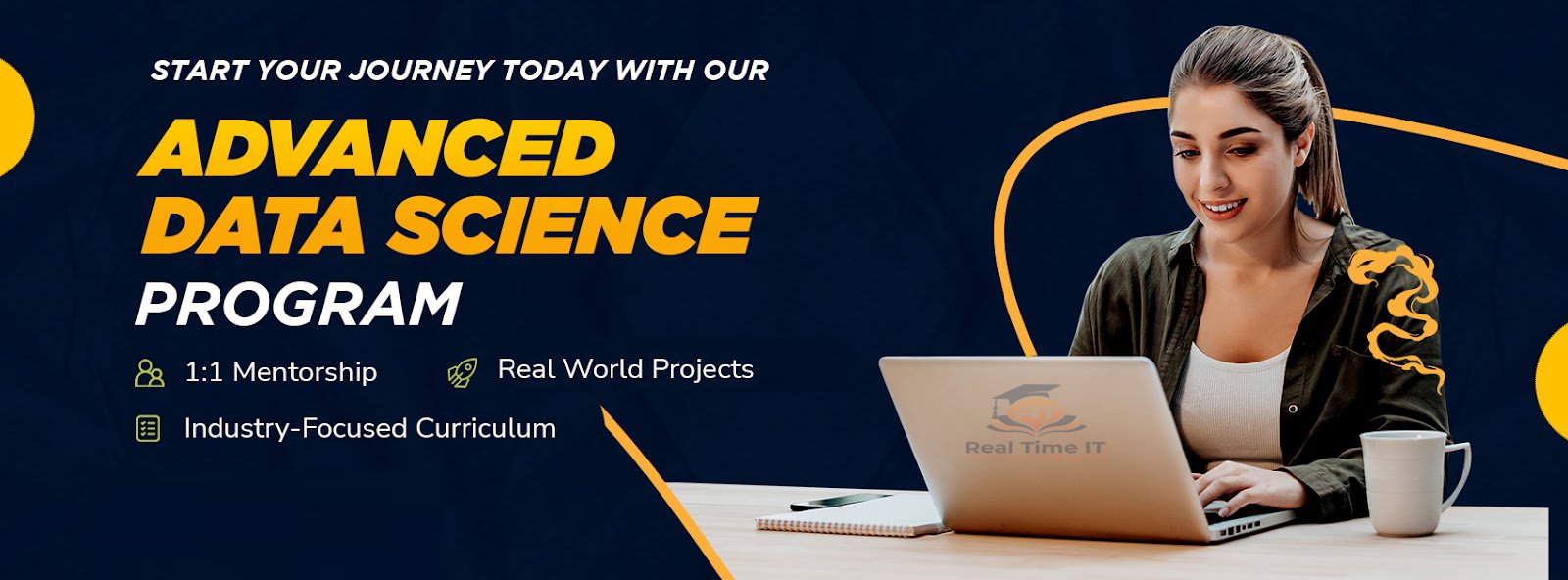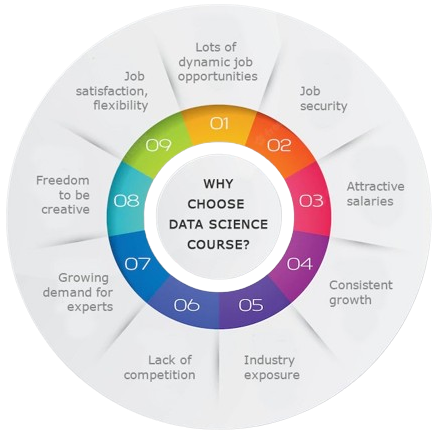Real Time IT Experts
Best Data Science Training Institute in Bangalore
Overview
DATA SCIENCE TRAINING
For Innovative Teaching And Learning Research Solutions
REAL TIME IT EXPERTS is one of the best in software training in Bangalore, We delivered the training for many individuals, groups, and corporations, We prioritize to give our best quality of training and further assistance, You have complete freedom to customize course topics and time, REAL TIME IT EXPERTS is a good experience and a generation ahead. Register yourself for unbelievable prices.

15 +
Years Experience
20 +
Real Time Trainers
100 %
Placement
24 /7
Flexible Timing
BOOK A FREE DEMO
Module 1 -Getting started
- What is Data Science?
- Reasons to use Data Science
- Project Lifecycle
- Data Acquirement
- Evaluation of Input Data
- Transforming Data
- Statistical and analytical methods to work with data
- Machine Learning basics
- Introduction to Recommender systems
- Apache Mahout Overview
Module 2 – Reasons to Use
- What is Data Science?
- What Kind of Problems can you solve?
- Data Science Project Life Cycle
- Data Science-Basic Principles
- Data Acquisition
- Data Collection
- Understanding Data- Attributes in a Data, Different types of Variables
- Build the Variable type Hierarchy
- Two Dimensional Problem
- Co-relation b/w the Variables- explain using Paint Tool
- Outliers, Outlier Treatment
- Boxplot, How to Draw a Boxplot
Module 3 – Acquiring Data
- Discussion on Boxplot – also Explain
- Example to understand variable Distributions
- What is Percentile? – Example using Rstudio tool
- How do we identify outliers?
- How do we handle outliers?
- Outlier Treatment: Using Capping/Flooring General Method
- Distribution- What is Normal Distribution?
- Why Normal Distribution is so popular?
- Uniform Distribution
- Skewed Distribution
- Transformation
Module 4 – Machine Learning in Data Science
- Discussion about Boxplot and Outlier
- Goal: Increase Profits of a Store
- Areas of increasing the efficiency
- Data Request
- Business Problem: To maximize shop Profits
- What are Interlinked variables
- What is Strategy
- Interaction b/w the Variables
- Univariate analysis
- Multivariate analysis
- Bivariate analysis
- Relation b/w Variables
- Standardize Variables
- What is Hypothesis?
- Interpret the Correlation
- Negative Correlation
- Machine Learning
Module 5 –Statistical and Analytical Methods
- Correlation b/w Nominal Variables
- Contingency Table
- What is Expected Value?
- What is Mean?
- How Expected Value is differ from Mean
- Experiment – Controlled Experiment, Uncontrolled Experiment
- Degree of Freedom
- Dependency b/w Nominal Variable & Continuous Variable
- Linear Regression
- Extrapolation and Interpolation
- Univariate Analysis for Linear Regression
- Building Model for Linear Regression
- Pattern of Data means?
- Data Processing Operation
- What is sampling?
- Sampling Distribution
- Stratified Sampling Technique
- Disproportionate Sampling Technique
- Balanced Allocation-part of Disproportionate Sampling
- Systematic Sampling
- Cluster Sampling
- 2 angels of Data Science-Statistical Learning, Machine Learning
DATA SCIENCE COURSE CONTENTS

Module 6 – Testing and Assessment
- Multi variable analysis
- linear regration
- Simple linear regration
- Hypothesis testing
- Speculation vs. claim(Query)
- Sample
- Step to test your hypothesis
- performance measure
- Generate null hypothesis
- alternative hypothesis
- Testing the hypothesis
- Threshold value
- Hypothesis testing explanation by example
- Null Hypothesis
- Alternative Hypothesis
- Probability
- Histogram of mean value
- Revisit CHI-SQUARE independence test
- Correlation between Nominal Variable
Module 7 – Business Algorithms
- Machine Learning
- Importance of Algorithms
- Supervised and Unsupervised Learning
- Various Algorithms on Business
- Simple approaches to Prediction
- Predict Algorithms
- Population data
- sampling
- Disproportionate Sampling
- Steps in Model Building
- Sample the data
- What is K?
- Training Data
- Test Data
- Validation data
- Model Building
- Find the accuracy
- Rules
- Iteration
- Deploy the model
Module 8 – Segmentation of Prediction and Analysis
- Clustering
- Cluster and Clustering with Example
- Data Points, Grouping Data Points
- Manual Profiling
- Horizontal & Vertical Slicing
- Clustering Algorithm
- Criteria for take into Consideration before doing Clustering
- Graphical Example
- Clustering & Classification: Exclusive Clustering, Overlapping Clustering, Hierarchy Clustering
- Simple Approaches to Prediction
- Different types of Distances: 1.Manhattan, 2.Euclidean, 3.Consine Similarity
- Clustering Algorithm in Mahout
- Probabilistic Clustering
- Pattern Learning
- Nearest Neighbor Prediction
- Nearest Neighbor Analysis
Module 9 – Integration of R and Hadoop
- R introduction
- How R is typically used
- Features of R
- Introduction to Big data
- R+Hadoop
- Ways to connect with R and Hadoop
- Products
- Case Study
- Architecture
- Steps for Installing RIMPALA
- How to create IMPALA packages

